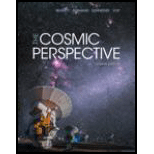
Comparing Jovian Moons. Roles: Scnbe (collects data and lakes notes on Ihe group’s activities), Proposer (proposes hypotheses and explanations of the data). Skeptic (points out weaknesses in ihe hypotheses and explanations). Moderator (leads group discussion and makes sure everyone contributes). Activity: Compare the moons of Jupiter, drawing on the data in Appendix E.
a. Collect data on Jupiter's four largest moons from Table E.2 in Appendix E and determine which moon has the greatest density, b. Use Table E.2 to determine what other solar system moon most resembles the moon from part a in mass, radius, and density, c. Propose a hypothesis about the composition of the moon from part a, based on its resemblance to the moon from pari b, and examine potential concerns about the viability of the hypothesis d. Use Table F.,2 to determine whether there is a trend in density with orbital distance among the major moons of Jupiter; briefly describe any trends, e. Suggest a hypothesis that accounts for any trend found in part d, and discuss potential concerns about the hypothesis, f. Develop and describe an experiment that could test the hypotheses in parts c and e.
Want to see the full answer?
Check out a sample textbook solution
Chapter 11 Solutions
The Cosmic Perspective (8th Edition)
- What is the maximum angular diameter of Jupiter as seen from Earth? Repeat this calculation for Neptune. Relevant data can be found in Celestial Profiles 7 and 10. (Hint: Use the small-angle formula in Reasoning with Numbers 3-1.)arrow_forwardWe have a lot of good images of the large moons of Jupiter and Saturn from the Galileo and Cassini spacecraft missions (check out NASA’s Planetary Photojournal site, at http://photojournal.jpl.nasa.gov, to see the variety). Now that the New Horizons mission has gone to Pluto, why don’t we have as many good images of all sides of Pluto and Charon?arrow_forwardConclusion(s) and evidence from investigation: 1. What is the relationship between mass and gravity? 2. How is mass and gravity relevant to the formation of the solar system? (think about the sun) 3. Describe the shape of the solar system. 4. Describe the composition (what it is made of) of the solar system. 5. Describe the revolution (orbit) of the solar system. 6. Identify an anomaly (doesn't match the rest) in the data and propose an explanation for it. 7. What were some patterns you found in the columns? List at least 2. 8. Which is the best evidence that the solar system was created from accretion? Explain why. (There may be more than 1!)arrow_forward
- 1. Which of these is not a criteria for the success of a solar system formation theory?arrow_forward6. N. TEBOOK 1. Draw and label a picture of the asteroid belt that shows how far the asteroid belt is from the sun in AUs. Include the sun and Earth in your picture.arrow_forwardWhat is the maximum angular diameter of the largest asteroid, Ceres, as seen from Earth? Can Earth-based telescopes detect surf ace features? Can the Hobble Space Telescope’ (Hint: Use the small-angle formula in Reasoning with Numbers 3-1.) (Notes: The angular resolution of Earth-based telescopes is about 1 arc second and of HST about 0.1 arc second. Ceres’ average distance from the Sun is 2.8 AU.)arrow_forward
- What does the term differentiated mean when applied to a planet? Would you expect to find that planets are usually differentiated? Why?arrow_forwardI need helps on this question?arrow_forwardWhat is the frost line in the solar nebula? Explain how temperature differences led to the formation of two distinct types of planets.arrow_forward
- B. Complete the Venn Diagram using the characteristics on the next page Meteors Asteroids Comets Characteristics to include in the Venn Diagram: 1. Progress across the sky very slowly 10. Remnants of the formation of the solar system 11. Rocky composition 2. Reflect sunlight 3. Orbit the Sun in highly elliptical orbits 12. Measure a few kilometers in diameter 4. Most found în the asteroid belt 13. Most are less than a km in diameter 5. Most have slightly elliptical orbits 14. Most are less than 100 m in diameter 6. Also known as shooting stars 15. Most burn up as they enter Earth's 7. Streak across the sky very fast 16. Most are fragments of large asteroids 17. Tail always points away from the Sun 8. lcy objects 9. Meteor showers are caused by the Earth passing through the debris path of acomet Hand&cience HSarrow_forward1. Suppose you have an Oort cloud comet on an orbit with pericenter distance 10,000 AU, and apocenter distance 20,000 AU. a. What are the semi-major axis and eccentricity of the orbit? b. What are the specific energy (energy per unit mass), and specific angular momentum (angular momentum per unit mass) of the comet? c. How fast is the comet moving at apocenter (relative to the Sun)?arrow_forwardThe reason that most moons in our solar system orbit in all sorts of crazy directions is because most moons a. co-formed with their planets b. are the result of major collisions c. have been pulled into these crazy orbits by tidal forces d. are captured asteroids Tidal flexing will occur in a moon whose orbit is a. close to its planet and circular b. far from its planet and circular c. far from its planet and eccentric d. close to its planet and eccentricarrow_forward

 Horizons: Exploring the Universe (MindTap Course ...PhysicsISBN:9781305960961Author:Michael A. Seeds, Dana BackmanPublisher:Cengage Learning
Horizons: Exploring the Universe (MindTap Course ...PhysicsISBN:9781305960961Author:Michael A. Seeds, Dana BackmanPublisher:Cengage Learning AstronomyPhysicsISBN:9781938168284Author:Andrew Fraknoi; David Morrison; Sidney C. WolffPublisher:OpenStax
AstronomyPhysicsISBN:9781938168284Author:Andrew Fraknoi; David Morrison; Sidney C. WolffPublisher:OpenStax Foundations of Astronomy (MindTap Course List)PhysicsISBN:9781337399920Author:Michael A. Seeds, Dana BackmanPublisher:Cengage Learning
Foundations of Astronomy (MindTap Course List)PhysicsISBN:9781337399920Author:Michael A. Seeds, Dana BackmanPublisher:Cengage Learning
 An Introduction to Physical SciencePhysicsISBN:9781305079137Author:James Shipman, Jerry D. Wilson, Charles A. Higgins, Omar TorresPublisher:Cengage Learning
An Introduction to Physical SciencePhysicsISBN:9781305079137Author:James Shipman, Jerry D. Wilson, Charles A. Higgins, Omar TorresPublisher:Cengage Learning





